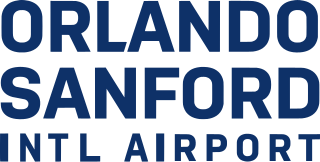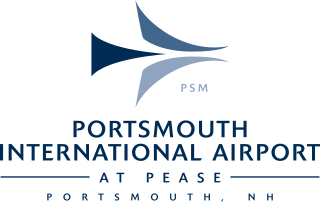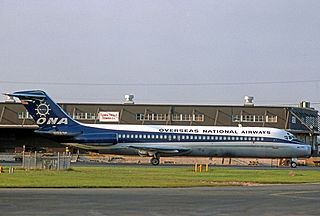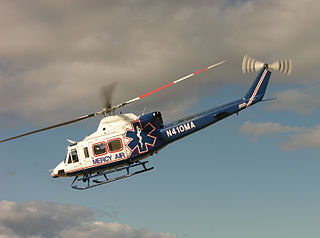
Orlando Sanford International Airport is in Sanford, Florida, United States, near Orlando. It was built as Naval Air Station Sanford, a Master Jet Base for carrier-based attack and reconnaissance aircraft, and was used by the U.S. Navy until 1969. The airport is owned and operated by the Sanford Airport Authority. It serves as an operating base for Allegiant Air.

Portsmouth International Airport at Pease, formerly known as Pease International Airport, is a joint civil and military use airport located one nautical mile (2 km) west of the central business district of Portsmouth, a city in Rockingham County, New Hampshire, United States. It is owned by the Pease Development Authority. It is included in the Federal Aviation Administration (FAA) National Plan of Integrated Airport Systems for 2017–2021, in which it is categorized as a non-hub primary commercial service facility.

The Eurocopter AS350 Écureuil, now Airbus Helicopters H125, is a single-engine light utility helicopter originally designed and manufactured in France by Aérospatiale and Eurocopter. In North America, the AS350 is marketed as the AStar. The AS355 Ecureuil 2 is a twin-engine variant, marketed in North America as the TwinStar. The Eurocopter EC130 is a derivative of the AS350 airframe and is considered by the manufacturer to be part of the Écureuil single-engine family.

Addison Airport is a public airport in Addison, in Dallas County, Texas, United States, 9 mi north of downtown Dallas. It opened in 1954 and was purchased by the town of Addison in 1976. It is home to the Cavanaugh Flight Museum.

Northeast Airlines Flight 946 was a domestic U.S. flight from Boston, Massachusetts, to Montpelier, Vermont, with a scheduled stop in Lebanon, New Hampshire, operated by Northeast Airlines. On October 25, 1968, some time during the evening, the Fairchild Hiller FH-227 aircraft crashed on Moose Mountain while descending on approach. The crash killed 32 of 42 passengers and crew. Of the fatalities, four were employees from the National Life Insurance Company who were returning from a business trip. The fatalities also included a reporter for the Barre Daily Times and six social workers of the Vermont Head Start Supplementary Training Program on a conference trip. Ten passengers survived the crash with minor or moderate injuries. After the crash, Northeast Airlines continued flight service until its merger with Delta Air Lines in the early 1970s.

The EurocopterEC130 is a single engine light utility helicopter developed from the earlier Eurocopter AS350 Écureuil, one of the primary changes from which was the adoption of a Fenestron anti-torque device in place of a conventional tail rotor. It was launched and produced by the Eurocopter Group, which would later be rebranded as Airbus Helicopters.

The EurocopterAS355 Écureuil 2 is a twin-engine light utility helicopter developed and originally manufactured by Aérospatiale in France.

ALM Antillean Airlines Flight 980 was a flight scheduled to fly from John F. Kennedy International Airport in New York City to Princess Juliana International Airport in St. Maarten, Netherlands Antilles, on May 2, 1970. After several unsuccessful landing attempts, the aircraft's fuel was exhausted, and it made a forced water landing in the Caribbean Sea 48 km off St. Croix, with 23 fatalities and 40 survivors. The accident is one of a small number of intentional water ditchings of jet airliners.

The Champion 402 Lancer is a twin-engine trainer produced by Champion Aircraft, a high-wing monoplane based on the tricycle gear Champion 7FC Tri-Traveler, but with wing-mounted Continental O-200-A engines. The Lancer first flew in 1961 and production began in 1963. The Lancer seats two in a tandem configuration with dual flight controls; the pilot in command or student pilot normally occupies the front seat.

The safety of emergency medical services flights has become a topic of public interest in the United States, with the expansion of emergency medical services aviation operations, such as air ambulance and MEDEVAC, and the increasing frequency of related accidents.

Mineral Wells Airport is a public airport four miles southeast of Mineral Wells, Texas. The National Plan of Integrated Airport Systems for 2011–2015 called it a general aviation facility. It is owned and operated by the city of Mineral Wells. The airport, and the city, lie in Palo Pinto County and Parker County. The terminal is in Parker County.
Northwest Regional Airport is a privately owned, public use airport 3 nautical miles (5.6 km) northwest of Roanoke, in Denton County, Texas, United States.

Colgan Air Flight 3407 was a scheduled passenger flight from Newark, New Jersey, US to Buffalo, New York, US on February 12, 2009. Colgan Air staffed and maintained the aircraft used on the flight that was scheduled, marketed and sold by Continental Airlines under its Continental Connection brand. The aircraft, a Bombardier Q400, entered an aerodynamic stall from which it did not recover and crashed into a house at 6038 Long Street in Clarence Center, New York at 10:17 pm EST, killing all 49 passengers and crew on board, as well as one person inside the house.

On August 8, 2009, at 11:53 a.m. (15:53 UTC), nine people died when a tour helicopter and a small private airplane collided over the Hudson River near Frank Sinatra Park in Hoboken, New Jersey, United States. The aircraft were in an area known as the "Hudson River VFR Corridor", which extends from the surface of the river to altitudes of 800 to 1,500 ft at various locations along the Hudson River in the immediate area of New York City. Within this corridor, aircraft operate under visual flight rules (VFR), under which the responsibility to see and avoid other air traffic rests with the individual pilots rather than with the air traffic controller.

The Grand Canyon mid-air collision occurred when Grand Canyon Airlines Flight 6, a de Havilland Canada DHC-6 Twin Otter, collided with a Bell 206 helicopter, Helitech Flight 2, over Grand Canyon National Park on June 18, 1986. All 25 passengers and crew on board the two aircraft were killed. It remains the deadliest accident involving a helicopter on United States soil, surpassing the crash of Los Angeles Airways Flight 841 in 1968, which killed 23 people.

The Bell 525 Relentless is an American super-medium-lift helicopter, under development by Bell Textron. The Bell 525 was unveiled at the 2012 Heli-Expo in Dallas, Texas in February 2012. The helicopter first flew on 1 July 2015. It is designed to transport up to 19 passengers.

On July 7, 2017, an Airbus A320-211 operating as Air Canada Flight 759 was nearly involved in an accident at San Francisco International Airport in San Mateo County, California, United States. The flight, which originated at Toronto Pearson International Airport, had been cleared by air traffic control to land on runway 28R and was on final approach to land on that runway; however, instead of lining up with the runway, the aircraft had lined up with the parallel taxiway, on which four fully loaded and fueled passenger airplanes were stopped awaiting takeoff clearance. The flight crew initiated a go-around prior to landing, after which it landed without further incident. The aircraft on the taxiway departed for their intended destinations without further incident. The subsequent investigation by the National Transportation Safety Board (NTSB) determined that the Air Canada airplane descended to 59 feet (18 m) above the ground before it began its climb, and that it missed colliding with one of the aircraft on the taxiway by 14 feet (4.3 m).

On 4 August 2018, a de Havilland Canada DHC-2 Beaver aircraft operated by K2 Aviation crashed in poor weather near Denali, Alaska, United States. All five people on board survived the crash, but died before rescuers were able to arrive at the scene. The five people consisted of the pilot and four Polish tourists.

On May 13, 2019, a de Havilland Canada DHC-2 Beaver floatplane operated by Mountain Air Service collided with a Taquan Air de Havilland Canada DHC-3 Turbine Otter floatplane over George Inlet, Alaska, United States. The DHC-2 broke up in mid-air with the loss of all four passengers and the pilot. The DHC-3 pilot was able to maintain partial control, but the aircraft sustained substantial damage in the collision and the subsequent forced landing; the pilot suffered minor injuries, nine passengers suffered serious injuries, and one passenger was killed. Both aircraft were conducting sightseeing flights under visual flight rules, which state that the pilot of each aircraft is responsible for visually ensuring adequate separation from other air traffic, commonly known as "see and avoid".

Evergreen International Airlines Flight 17 (4U17/EIA17) was a cargo flight operated by Evergreen International Airlines and flown by a McDonnell Douglas DC-9. On March 18, 1989, the flight's planned route was scheduled to take it from Kelly Air Force Base to Tinker Air Force Base, with a stop at Carswell Air Force Base in Fort Worth, Texas. The two pilots were the only occupants on board. Immediately after takeoff from Carswell, the aircraft's main cargo door opened, the crew lost control of the aircraft and it subsequently crashed while attempting an emergency landing, killing both pilots.























